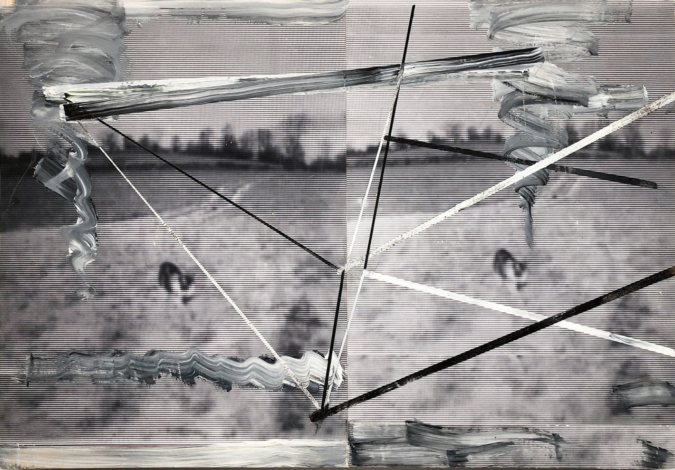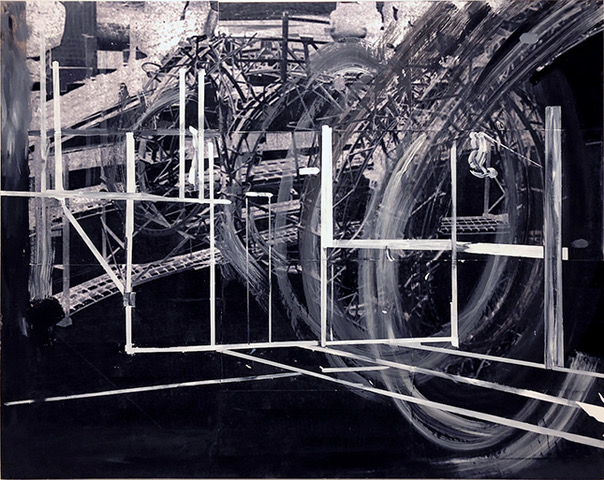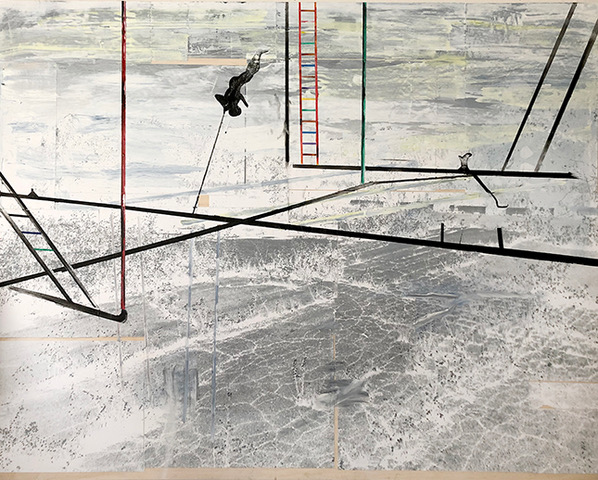Heide Fasnacht
Question:
What could the painting process offer you that sculpture making couldn’t?
Answer:
…the photograph is not an index of the world but is an index of the negative – a negative that may have captured ‘something we don’t recognize. 1
In short, for me the peculiar combination of photography and painting that I have been pursuing since Feb 2018 has offered a simpler, more direct route to what I need to express.
Like all change, it seems more sudden than it is. Subterranean processes, largely unknown, take place long before the first bit of land emerges from the surface of the water. For years I’ve been searching for this directness, this more contemplative space. When I made the exploding sculptures, I found a friend in urethane foam, which like the thing it depicts, explodes out of the can. I could use it quickly and directly. Perhaps more pertinent is the use of tape in the anamorphic projections. In addition to being a quick and direct graphic stroke on a wall, it limned a space simultaneously real and unreal.
It is all about staying on the bead. The exquisite presence. The heightened awareness. The emotional availability to making use of an accident amid the presence of control. Having made art for over 50 years, having tried practically everything in art and in life, it all comes down to this: how to swat away distractions to get to the essence of something. And for me the signpost says “some particular amalgam of collage and painting” population 1.
This all takes place roughly in a sequence like this: I search for an image that pricks my sense of what I am looking for, with some indescribable magnetic pull. Perhaps it is a nostalgic image of an old playground that lives in my past, coupled with some knowing entry into it via my heart and brain. It is not easily knowable. The vertigo, spatial confusion, sympathetic wish to climb, swing, drop, grip and let go are all yours (as viewer) and mine. To describe something as Sebaldian is to invoke something that is knowable but still indescribable
For example, an image of a stereopticon photo of matching dogs compels in an uncanny way. Are they two dogs or doppelgängers of one another? Is the landscape sequential (is there movement) like in an old Hanna-Barbera cartoon one a replica of the other. Or is it a before and after? And if so which is which? Long stretches of time are spent gazing at this then the paint comes in. Oftentimes the first response is later obliterated. That obliteration, either with patches of “band-aids” or a whirlwind of paint or a patch which reopens possibilities, makes it more interesting but not clearer. The painting process then becomes paramount. It is a second way to reveal or obscure, to find surprises via its innate fluidity, to confound and revivify through its touch. Then an integration (not mere synthesis) takes place. It has also been a space where I’ve now lived for awhile, a digestive process has taken place – hence the integration. It becomes a painting. It depicts no easily knowable thing, but rather offers an apparatus for the psyche.
For nothing is really itself anymore. There are pieces of this and pieces of that, but none of it fits together. And yet, very strangely, at the limit of all this chaos, everything begins to fuse again. A pulverized apple and a pulverized orange are finally the same, […] At a certain point, things disintegrate into muck, or dust, or scraps, and what you have is something new, some particle or agglomeration of matter that cannot be identified. It is a clump, a mote, a fragment of the world that has no place: a cipher of it-ness. […] The job is to zero in on these islands of intactness, to imagine them joined to other such islands, and those islands to still others, and thus to create new archipelagoes of matter.i 2
- Lisa Pate, ed. “Introduction. Searching for Sebald: What I know for sure,” Searching for Sebald: Photography After W.G. Sebald, Los Angeles: The Institute of Cultural Inquiry, 2007, pp. 92.
- i Paul Auster, In the Country of Last Things, London and Boston: Faber and Faber, 1987, pp. 35-36.








